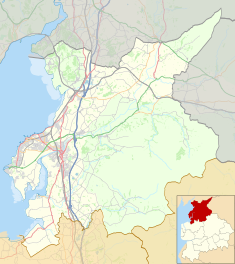| Wennington Hall | |
|---|---|
 | |
| Location | Wennington, Lancashire |
| Coordinates | 54°07′44″N 2°35′27″W / 54.1288°N 2.5908°W |
| Architect | E. G. Paley |
Listed Building – Grade II | |
| Official name | Wennington Hall |
| Designated | 4 December 1985 |
| Reference no. | 1165274[1] |
Wennington Hall is a former country house in Wennington, a village in the City of Lancaster district in Lancashire, England. The house is a Grade II listed building and from 1940 until 2022 was used as a school, at first by the Quaker boarding school Wennington School before its move to Yorkshire, then by Lancashire County Council.
History
[edit]In its early history, Wennington Hall was the seat of William de Wennington. and in the 14th century, it passed to the Morley family.[2] In 1674 the hall was sold to Henry Marsden, MP for Clitheroe. It descended to Henry Marsden, who lived at the hall with his younger brother John, known as "Silly Marsden", and their aunt. Henry died in 1780 from alcoholism and John was induced by his guardian aunt and her ambitious husband to sell the hall and buy Hornby Castle, Lancashire.[3] Wennington was bought in 1788 by the Rev Anthony Lister, who took the surname Marsden. The hall was later sold to Richard Saunders in 1841.[2]
The present building on the site, designed by Lancaster architect Edward Graham Paley, was constructed in 1855–56 for Richard's son William Allen Francis Saunders, High Sheriff of Lancashire in 1862.[4][5] After him it passed to Charles Morley Saunders and later William Morley Saunders.[6] During the Second World War it housed the Wennington School, who moved to Ingmanthorpe Hall in Yorkshire at the end of the war.[7]
From 1954 until 2022 it was occupied by Wennington Hall School, a Lancashire County Council boarding school for boys with learning or behavioural difficulties.[8]
After the school's closure the building was acquired by Bowland Inns & Hotels; in 2023 planning permission was granted for its conversion to a hotel.[9] It is expected to open in spring 2024.[10]
Wennington Hall was designated as a Grade II listed building on 4 December 1985. The Grade II designation—the lowest of the three grades—is for buildings that are "nationally important and of special interest".[11]
Architecture
[edit]Wennington Hall is built of sandstone rubble. Most of the roofs are stone slate.[1] The plan is asymmetric and there is a large crenellated tower to the rear.[4] The front facade is gabled.[5] The house is in two storeys, and is in Tudor Revival style. Inside the house is a staircase hall with a hammerbeam roof, and stained glass.[12] Connected to the main building, there is a stable block that has its own crenellated tower. The main section of the building is in Tudor revival style with wooden beams going across the ceiling of the central section of the building. The main door still remains in its original form and has been treated with care, the walls of the grounds still also remain in their original forms.[4]
See also
[edit]References
[edit]Citations
[edit]- ^ a b Historic England, "Wennington Hall (1165274)", National Heritage List for England, retrieved 21 June 2015
- ^ a b Burke (1852), p. 285
- ^ Hull, G. (1999). "John Marsden's Will: The Hornby Castle Dispute 1780–1840". Journal of the Royal Society of Medicine. 92 (3): 149–150. doi:10.1177/014107689909200319. PMC 1297114.
- ^ a b c Hartwell & Pevsner (2009), p. 684
- ^ a b Robinson (1991), p. 250
- ^ "A History of the County of Lancaster: Volume 8". British History Online. Retrieved 17 January 2013.
- ^ "Wennington School 1940–1975". Retrieved 17 January 2013.
- ^ Welcome, Wennington Hall School, retrieved 18 September 2012
- ^ Wilson, Chloe (21 August 2023). "Bowland Inns & Hotels secures planning permission for Wennington Hall". Lancashire Telegraph. Retrieved 25 October 2023.
- ^ Hodgson, Neil (11 October 2023). "Hotels and venues group on road to growth following £25m loan". TheBusinessDesk.com. Retrieved 25 October 2023.
- ^ Historic England, Listed Buildings, retrieved 21 June 2015
- ^ Brandwood et al. 2012, p. 71.
Sources
[edit]- Brandwood, Geoff; Austin, Tim; Hughes, John; Price, James (2012), The Architecture of Sharpe, Paley and Austin, Swindon: English Heritage, ISBN 978-1-84802-049-8
- Burke, Bernard (1852), A Genealogical and Heraldic Dictionary of the Landed Gentry of Great Britain & Ireland for 1852, Colburn and Co., OCLC 15669510
- Hartwell, Clare; Pevsner, Nikolaus (2009) [1969], Lancashire: North, New Haven and London: Yale University Press, ISBN 978-0-300-12667-9
- Robinson, John Martin (1991), A Guide to the Country Houses of the North West, Constable, ISBN 0-09-469920-8

